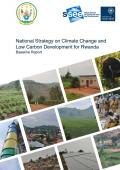Written by the research team of at the Institute for Labor Studies, Ministry of Human Resources and Social Security, China, this study presents both the current situation and potential for green employment in China, as well as results of surveys conducted in eight companies in the power industry. In China, green employment can be defined as work in industries, sectors, enterprises, and positions which have low input, high output, low consumption, low emissions, recyclability and sustainability. The purpose of the study is to make policy recommendations for China’s transition toward green employment.

This Baseline Report is the first step in the process of developing a National Strategy on Climate Change and Low Carbon Development for Rwanda. It provides a snapshot of the country today and the planned initiatives that will take it forward, placing it within the context of climate change. Though many opportunities are highlighted, the aim of the report is to provide the foundation for the next step where detailed analysis will take place and recommendations will be made. It includes an analysis of the following sectors: climate policy; economy, trade and industry; energy; mining; transport; cities and the built environment; agriculture; land; water and forestry.
This summary was prepared by Eldis.
Every day, unsustainable patterns of consumption, unsustainable production methods and population growth challenge the resilience of the planet to support human activities. At the same time, inequalities between and within societies remain high leaving billions with unmet basic human needs and a disproportionate vulnerability to global environmental change. To counteract this trend, UNEP and SETAC have worked together to develop the current work Towards a Life Cycle Sustainability Assessment. This has been achieved through the UNEP/SETAC Life Cycle Initiative.
A key objective of the UNEP/SETAC Life Cycle Initiative is to help extend life cycle assessment (LCA) methods and practices. One major achievement has been the development of methods and techniques that can measure sustainability and allow LCA to support decision-making toward more sustainable product and process systems. In this way, life cycle techniques can be used to carry out life cycle sustainability assessments. This guidance document provides a starting point for learning about the methodologies and techniques suitable for life-cycle-based ways of measuring sustainability.
This report was prepared by the UN EMG's Issue Management Group on Green Economy to assess how the United Nations system could coherently support countries in transitioning to a green economy. The report aimes to facilitate a common understanding of the green economy approach and the measures required for the transition. This report was written in the run-up to the 2012 UN Conference on Sustainable Development (Rio+20), where one of the themes was "green economy in the context of sustainable development and poverty eradication".
This report is the first comprehensive study on the emergence of a “green economy” and its impact on the world of work. It includes data that shows a changing pattern of employment in which green jobs are being generated in many sectors and economies around the world as a result of measures to tackle climate change and to reduce emissions of greenhouse gases. This has also led to changing patterns of investment flows into areas such as renewable energy and energy efficiency at the household and industrial level. Within current policy frameworks, only a fraction of the potential benefits for jobs and development is forthcoming.
